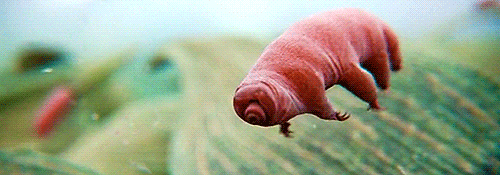Fascinating animal. Rather long description, but may answer some questions expressed here;
Tardigrade - Wikipedia, the free encyclopedia
Taxonomy[edit]
See also:
List of bilaterial animal orders

Illustration of
Echiniscus sp. from 1861
Scientists have conducted
morphological and molecular studies to understand how tardigrades relate to other lineages of ecdysozoan animals. Two plausible placements have been proposed: tardigrades are either most closely related to
Arthropoda ±
Onychophora, or tardigrades are most closely related to
nematodes. Evidence for the former is a common result of
morphological studies; evidence of the latter is found in some molecular analyses.
The latter hypothesis has been rejected by recent
microRNA and expressed sequence tag analyses.
[53] Apparently, the grouping of tardigrades with nematodes found in a number of molecular studies is a
long branch attraction artifact. Within the arthropod group (called panarthropoda and comprising onychophora, tardigrades and euarthropoda), three patterns of relationship are possible: tardigrades sister to
onychophora plus arthropods (the
lobopodia hypothesis); onychophora sister to tardigrades plus arthropods (the tactopoda hypothesis); and onychophora sister to tardigrades.
[54] Recent analyses indicate that the panarthropoda group is monophyletic, and that tardigrades are a sister group of Lobopodia, the lineage consisting of
arthropods and
Onychophora.
[53][55]
Panarthropoda
Water bears (Tardigrada)
Lobopoda
Velvet worms (Onychophora)
Arthropods (Arthropoda)
The minute sizes of tardigrades and their membranous integuments make their
fossilization both difficult to detect and highly unusual. The only known fossil specimens are those from mid-
Cambrian deposits in
Siberia and a few rare specimens from
Cretaceous amber.
[56]
The Siberian tardigrade fossils differ from living tardigrades in several ways. They have three pairs of legs rather than four, they have a simplified head morphology, and they have no posterior head appendages, but they share with modern tardigrades their columnar cuticle construction.
[57] Scientists think they represent a stem group of living tardigrades.
[56]
Rare specimens in Cretaceous amber have been found in two North American locations.
Milnesium swolenskyi, from
New Jersey, is the older of the two; its claws and mouthparts are indistinguishable from the living
M. tardigradum. The other specimens from amber are from western
Canada, some 15–20 million years earlier than
M. swolenskyi. One of the two specimens from Canada has been given its own genus and family,
Beorn leggi (the genus named by Cooper after the character
Beorn from
The Hobbit by
J. R. R. Tolkienand the species named after his student William M. Legg); however, it bears a strong resemblance to many living specimens in the family
Hypsibiidae.
[56][58]
Aysheaia from the middle Cambrian
Burgess shale has been proposed as a sister taxon to an arthropod-tardigrade clade.
[59]
Tardigrades have been proposed to be among the closest living relatives of the Burgess shale oddity
Opabinia.
[60]
Genomes and genome sequencing[edit]
Tardigrade
genomes vary in size, from about 75 to 800 megabase pairs of DNA.
[61] The genome of
Hypsibius dujardini has been sequenced.
[62] This genome project debunked a previous claim that this species had 17%
horizontal gene transfer from other bacteria, fungi, and viruses.
[63] Hypsibius dujardini has a compact genome and a generation time of about two weeks; it can be cultured indefinitely and cryopreserved.
[64]
The genome of
Ramazzottius varieornatus has been reported to have been sequenced, but the results of this effort have not been published or made publicly available.
[65


